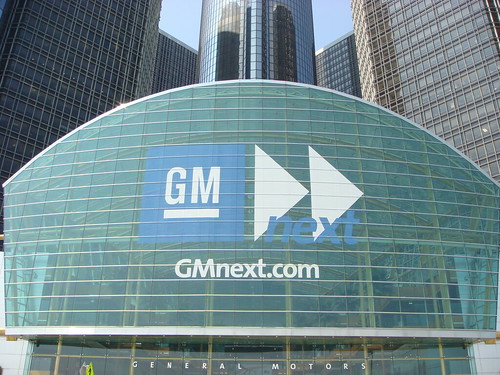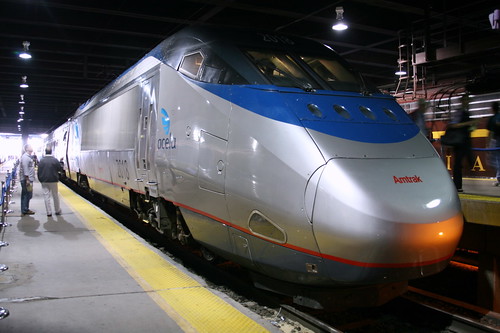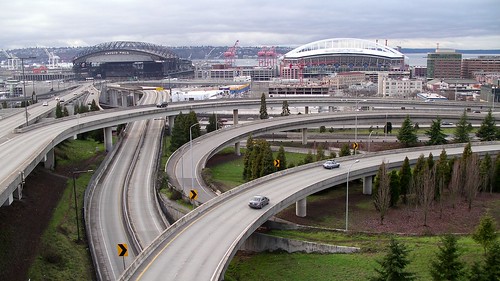G.O.P. Résumé, Cabinet Post, Knack for Odd Jobs – NY times profiles “Professor of Cocktail Situations” USDOT Sec. Ray LaHood
(Source: NY Times)
WASHINGTON — Ray LaHood, the secretary of transportation, is not one to toot his own horn over how much he knows about planes, trains and automobile bailouts. On the contrary.
 “I don’t think they picked me because they thought I’d be that great a transportation person,” Mr. LaHood says with refreshing indifference as to how this admission might play if, say, he were ever to bungle a bridge collapse.
“I don’t think they picked me because they thought I’d be that great a transportation person,” Mr. LaHood says with refreshing indifference as to how this admission might play if, say, he were ever to bungle a bridge collapse.Yes, transportation is Mr. LaHood’s day job, a post that a few days ago required him to attend a groundbreaking ceremony for a highway in New Hampshire, speak to a group about the dangers of tailgating trucks and discuss “bird strikes” on CNN.
But one of the astonishing things about Mr. LaHood, 63, is how limited his transportation résumé is, how little excitement he exudes on the subject (other than abouthigh-speed rail) and how little he seems to care who knows it. So why exactly did President Obama pick this former seven-term Republican congressman from Illinois to oversee everything that moves?
Mr. LaHood posits a theory. “They picked me because of the bipartisan thing,” he explained, “and the Congressional thing, and the friendship thing.”
The “bipartisan thing” and the “Congressional thing” are self-evident: Mr. LaHood is a Republican with close ties to Capitol Hill. One White House insider described Mr. LaHood as “a master of odd jobs,” whose knowledge of Washington allows him to take on assignments as varied as lobbying lawmakers on the budget and helping political novices in the cabinet navigate Beltway social rituals (“cocktail situations,” as Energy Secretary Steven Chu calls them).
In the White House, Mr. Chu describes Mr. LaHood, a former junior high school social studies teacher, as a source of “fatherly advice” for Washington newcomers like himself.
One “cocktail situation” occurred recently at the annual Gridiron Club dinner. Mr. LaHood was seated at the head table near Mr. Chu, and between Arne Duncan andTimothy F. Geithner, the education and Treasury secretaries. The men asked Mr. LaHood if they could flee the dinner before the interminable speechifying ended. No, Mr. LaHood counseled.
“I said, ‘Look, you’re window dressing,’ ” Mr. LaHood said. “ ‘You’re more of a prop. But it’s part of what we have to do.’ ” Mr. Chu and Mr. Duncan heeded the advice; Mr. Geithner did not.

 The so-called peak oil debate has taken many twists and turns over the years. After long being an oddball survivalist preoccupation, the debate gathered mainstream momentum a few years ago as oil prices began a long ascent from around $30 per barrel to $147, where they topped out last summer. By the time a barrel of West Texas crude was rising eight bucks a day, scarcity seemed like the best and only explanation–that no matter how hard we tried, we couldn’t pump enough oil to meet demand. OPEC cut production, inventories rose, and it seemed like, in fact, we had plenty of oil for the foreseeable future and the whole thing had just been hedge fund shenanigans.
The so-called peak oil debate has taken many twists and turns over the years. After long being an oddball survivalist preoccupation, the debate gathered mainstream momentum a few years ago as oil prices began a long ascent from around $30 per barrel to $147, where they topped out last summer. By the time a barrel of West Texas crude was rising eight bucks a day, scarcity seemed like the best and only explanation–that no matter how hard we tried, we couldn’t pump enough oil to meet demand. OPEC cut production, inventories rose, and it seemed like, in fact, we had plenty of oil for the foreseeable future and the whole thing had just been hedge fund shenanigans.







